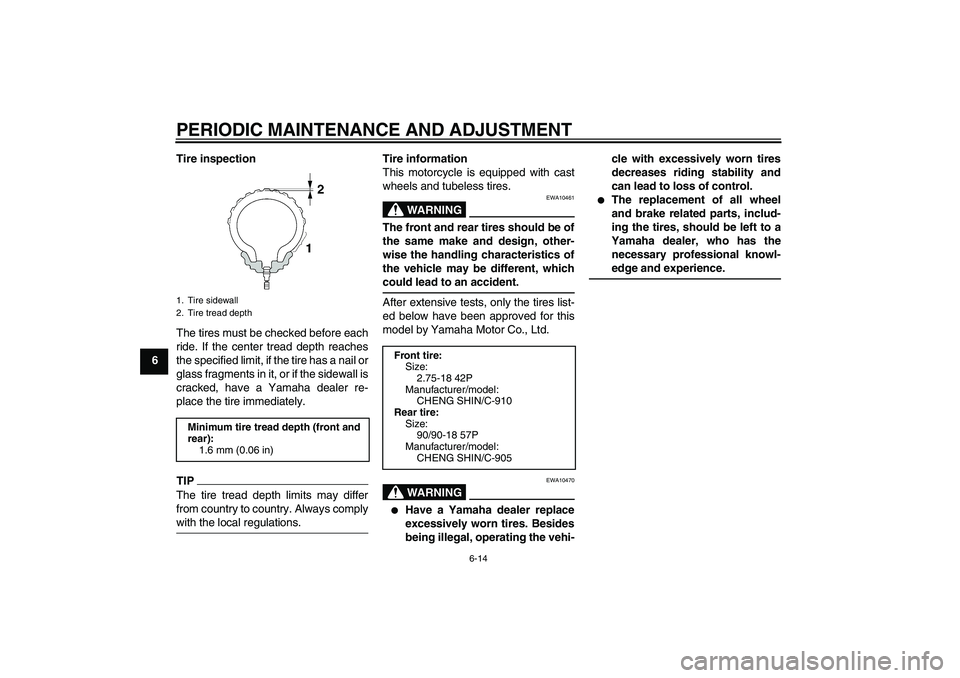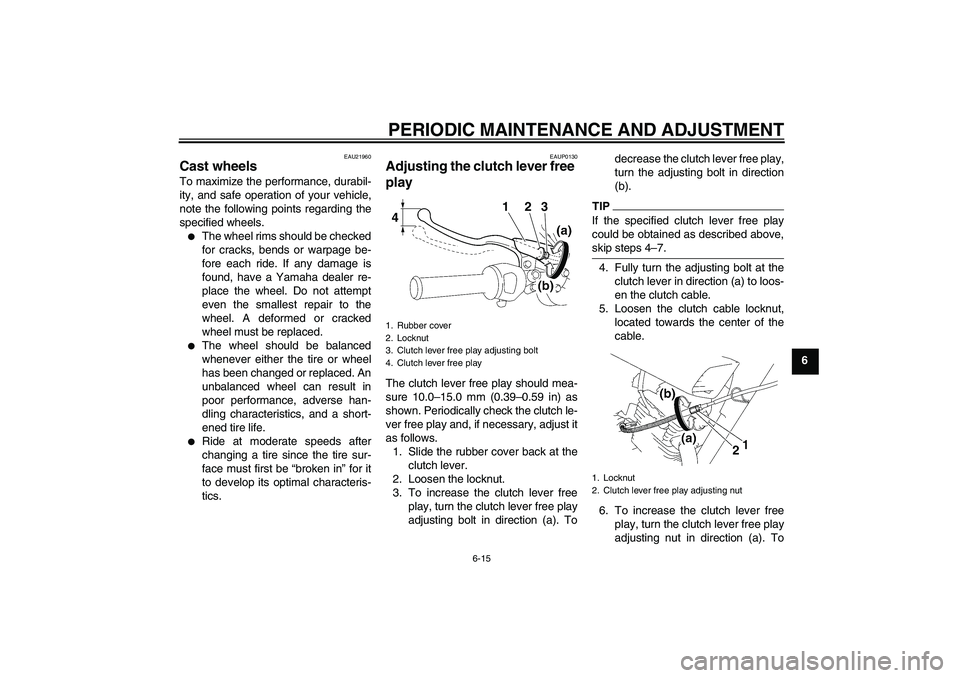Page 41 of 80

PERIODIC MAINTENANCE AND ADJUSTMENT
6-9
6
EAU37173
Engine oil The engine oil level should be checked
before each ride. In addition, the oil
must be changed at the intervals spec-
ified in the periodic maintenance and
lubrication chart.
To check the engine oil level
1. Place the vehicle on the center-
stand. A slight tilt to the side can
result in a false reading.
2. Start the engine, warm it up for
several minutes, and then turn it
off.
3. Wait a few minutes until the oil set-
tles, remove the oil filler cap, wipe
the dipstick clean, insert it back
into the oil filler hole (without
screwing it in), and then remove it
again to check the oil level.
TIPThe engine oil should be between the
minimum and maximum level marks.
4. If the engine oil is at or below the
minimum level mark, add sufficient
oil of the recommended type to
raise it to the correct level.
5. Insert the dipstick into the oil filler
hole, and then tighten the oil filler
cap.
To change the engine oil
1. Start the engine, warm it up for
several minutes, and then turn it
off.
2. Place an oil pan under the engine
to collect the used oil.
3. Remove the engine oil filler cap,
the engine oil drain bolt and its
gasket to drain the oil from the
crankcase.
1. Engine oil filler cap
1. Engine oil dipstick
2. Maximum level mark
3. Minimum level mark
U51DE0E0.book Page 9 Monday, November 2, 2009 10:34 AM
Page 42 of 80

PERIODIC MAINTENANCE AND ADJUSTMENT
6-10
64. Install the engine oil drain bolt and
its new gasket, and then tighten
the bolt to the specified torque.
5. Refill with the specified amount of
the recommended engine oil, and
then install and tighten the engine
oil filler cap.
NOTICE
ECA11620
�
In order to prevent clutch slip-
page (since the engine oil also
lubricates the clutch), do not
mix any chemical additives. Do
not use oils with a diesel speci-
fication of “CD” or oils of a high-
er quality than specified. In
addition, do not use oils labeled
“ENERGY CONSERVING II” or
higher.
�
Make sure that no foreign mate-
rial enters the crankcase.
6. Start the engine, and then let it idle
for several minutes while checking
it for oil leakage. If oil is leaking, im-
mediately turn the engine off and
check for the cause.
7. Turn the engine off, wait a few min-
utes until the oil settles, and then
check the oil level and correct it if
necessary.
EAU37123
Cleaning the air filter element The air filter element should be cleaned
at the intervals specified in the periodic
maintenance and lubrication chart.
Clean or, if necessary, replace the air
filter element more frequently if you are
riding in unusually wet or dusty areas.
1. Remove panel A. (See page 6-6.)
2. Remove the air filter case cover by
removing the screws.
3. Remove the air filter element.
1. Engine oil drain bolt
2. Gasket
3. Oil panTightening torque:
Engine oil drain bolt:
20 Nm (2.0 m·kgf, 14 ft·lbf)
Recommended engine oil:
See page 8-1.
Oil change quantity:
1.00 L (1.06 US qt, 0.88 Imp.qt)
1
3
2
1. Screw
2. Air filter case cover
U51DE0E0.book Page 10 Monday, November 2, 2009 10:34 AM
Page 43 of 80

PERIODIC MAINTENANCE AND ADJUSTMENT
6-11
6 4. Remove the sponge material from
the air filter element.
5. Lightly tap the air filter element to
remove most of the dust and dirt,
and then blow the remaining dirt
out with compressed air on the
mesh side as shown. If the air filter
element is damaged, replace it.6. Clean the sponge material with
solvent, then squeeze the remain-
ing solvent out, and be sure to let
the sponge material dry before in-
stalling it into the air filter element.
If the sponge material is damaged,
replace it. WARNING! Use only a
dedicated parts cleaning sol-
vent. To avoid the risk of fire or
explosion, do not use gasoline
or solvents with a low flash
point.
[EWA10431]
NOTICE: To avoid
damaging the sponge material,
handle it gently and carefully,
and do not twist it.
[ECA15101]
7. Install the sponge material into the
air filter element, and then install
the air filter element into the air fil-
ter case. NOTICE: Make sure that
the air filter element is properly
seated in the air filter case. The
engine should never be operat-
ed without the air filter element
installed, otherwise the pis-
ton(s) and/or cylinder(s) may
become excessively worn.
[ECA10481]
8. Install the air filter case cover by in-
stalling the screws.
9. Check the hose at the bottom of
the air filter case for accumulated
dust or water, and if necessary,
drain it by removing the clamp, and
then removing the plug.
1. Sponge material
2. Air filter element
1. Air filter element
1
U51DE0E0.book Page 11 Monday, November 2, 2009 10:34 AM
Page 44 of 80
PERIODIC MAINTENANCE AND ADJUSTMENT
6-12
610. Install the plug into the check
hose, and then install the clamp.
11. Install the panel.
EAU44734
Checking the engine idling
speed Check the engine idling speed and, if
necessary, have it corrected by a
Yamaha dealer.
EAU21383
Checking the throttle cable
free play The throttle cable free play should mea-
sure 3.0–7.0 mm (0.12–0.28 in) at the
inner edge of the throttle grip. Periodi-
cally check the throttle cable free play
and, if necessary, have a Yamaha deal-
er adjust it.
1. Clamp
2. Air filter check hose plug
Engine idling speed:
1300–1500 r/min
1. Throttle cable free play
1
U51DE0E0.book Page 12 Monday, November 2, 2009 10:34 AM
Page 45 of 80

PERIODIC MAINTENANCE AND ADJUSTMENT
6-13
6
EAU21401
Valve clearance The valve clearance changes with use,
resulting in improper air-fuel mixture
and/or engine noise. To prevent this
from occurring, the valve clearance
must be adjusted by a Yamaha dealer
at the intervals specified in the periodic
maintenance and lubrication chart.
EAU21562
Tires To maximize the performance, durabil-
ity, and safe operation of your motorcy-
cle, note the following points regarding
the specified tires.
Tire air pressure
The tire air pressure should be checked
and, if necessary, adjusted before each
ride.
WARNING
EWA10501
Operation of this vehicle with im-
proper tire pressure may cause se-
vere injury or death from loss of
control.�
The tire air pressure must be
checked and adjusted on cold
tires (i.e., when the temperature
of the tires equals the ambient
temperature).
�
The tire air pressure must be ad-
justed in accordance with the
riding speed and with the total
weight of rider, passenger, car-
go, and accessories approved
for this model.
WARNING
EWA10511
Never overload your vehicle. Opera-
tion of an overloaded vehicle could
cause an accident.
Tire air pressure (measured on cold
tires):
0–90 kg (0–198 lb):
Fr o nt :
175 kPa (1.75 kgf/cm², 25 psi)
Rear:
200 kPa (2.00 kgf/cm², 29 psi)
90–153 kg (198–337 lb):
Fr o nt :
175 kPa (1.75 kgf/cm², 25 psi)
Rear:
280 kPa (2.80 kgf/cm², 41 psi)
Maximum load*:
153 kg (337 lb)
* Total weight of rider, passenger, car-
go and accessories
U51DE0E0.book Page 13 Monday, November 2, 2009 10:34 AM
Page 46 of 80

PERIODIC MAINTENANCE AND ADJUSTMENT
6-14
6Tire inspection
The tires must be checked before each
ride. If the center tread depth reaches
the specified limit, if the tire has a nail or
glass fragments in it, or if the sidewall is
cracked, have a Yamaha dealer re-
place the tire immediately.
TIPThe tire tread depth limits may differ
from country to country. Always comply
with the local regulations.
Tire information
This motorcycle is equipped with cast
wheels and tubeless tires.
WARNING
EWA10461
The front and rear tires should be of
the same make and design, other-
wise the handling characteristics of
the vehicle may be different, which
could lead to an accident.After extensive tests, only the tires list-
ed below have been approved for this
model by Yamaha Motor Co., Ltd.
WARNING
EWA10470
�
Have a Yamaha dealer replace
excessively worn tires. Besides
being illegal, operating the vehi-cle with excessively worn tires
decreases riding stability and
can lead to loss of control.
�
The replacement of all wheel
and brake related parts, includ-
ing the tires, should be left to a
Yamaha dealer, who has the
necessary professional knowl-
edge and experience.
1. Tire sidewall
2. Tire tread depthMinimum tire tread depth (front and
rear):
1.6 mm (0.06 in)
Front tire:
Size:
2.75-18 42P
Manufacturer/model:
CHENG SHIN/C-910
Rear tire:
Size:
90/90-18 57P
Manufacturer/model:
CHENG SHIN/C-905
U51DE0E0.book Page 14 Monday, November 2, 2009 10:34 AM
Page 47 of 80

PERIODIC MAINTENANCE AND ADJUSTMENT
6-15
6
EAU21960
Cast wheels To maximize the performance, durabil-
ity, and safe operation of your vehicle,
note the following points regarding the
specified wheels.�
The wheel rims should be checked
for cracks, bends or warpage be-
fore each ride. If any damage is
found, have a Yamaha dealer re-
place the wheel. Do not attempt
even the smallest repair to the
wheel. A deformed or cracked
wheel must be replaced.
�
The wheel should be balanced
whenever either the tire or wheel
has been changed or replaced. An
unbalanced wheel can result in
poor performance, adverse han-
dling characteristics, and a short-
ened tire life.
�
Ride at moderate speeds after
changing a tire since the tire sur-
face must first be “broken in” for it
to develop its optimal characteris-
tics.
EAUP0130
Adjusting the clutch lever free
play The clutch lever free play should mea-
sure 10.0–15.0 mm (0.39–0.59 in) as
shown. Periodically check the clutch le-
ver free play and, if necessary, adjust it
as follows.
1. Slide the rubber cover back at the
clutch lever.
2. Loosen the locknut.
3. To increase the clutch lever free
play, turn the clutch lever free play
adjusting bolt in direction (a). Todecrease the clutch lever free play,
turn the adjusting bolt in direction
(b).
TIPIf the specified clutch lever free play
could be obtained as described above,
skip steps 4–7.4. Fully turn the adjusting bolt at the
clutch lever in direction (a) to loos-
en the clutch cable.
5. Loosen the clutch cable locknut,
located towards the center of the
cable.
6. To increase the clutch lever free
play, turn the clutch lever free play
adjusting nut in direction (a). To
1. Rubber cover
2. Locknut
3. Clutch lever free play adjusting bolt
4. Clutch lever free play4123
1. Locknut
2. Clutch lever free play adjusting nut
U51DE0E0.book Page 15 Monday, November 2, 2009 10:34 AM
Page 48 of 80

PERIODIC MAINTENANCE AND ADJUSTMENT
6-16
6decrease the clutch lever free play,
turn the adjusting nut in direction
(b).
7. Tighten the locknut at the clutch
cable.
8. Tighten the locknut at the clutch le-
ver, and then slide the rubber cov-
er to its original position.
EAUT1221
Checking the front brake lever
free play The brake lever free play should mea-
sure 0.0–7.0 mm (0.00–0.28 in) as
shown. Periodically check the brake le-
ver free play and, if necessary, have a
Yamaha dealer check the brake sys-
tem.
WARNING
EWA10641
An incorrect brake lever free play in-
dicates a hazardous condition in the
brake system. Do not operate the ve-
hicle until the brake system has
been checked or repaired by a
Yamaha dealer.
EAU39812
Adjusting the brake pedal free
play The brake pedal free play should mea-
sure 20.0–30.0 mm (0.79–1.18 in) at
the brake pedal end as shown. Period-
ically check the brake pedal free play
and, if necessary, adjust it as follows.
To increase the brake pedal free play,
turn the adjusting nut at the brake rod in
direction (a). To decrease the brake
pedal free play, turn the adjusting nut in
direction (b).
1. Brake lever free play
1. Brake pedal free play
U51DE0E0.book Page 16 Monday, November 2, 2009 10:34 AM